Teil 1
- Sobald Sie einen Preis für Ihre Produkte angegeben haben, können Sie bei Bedarf Logistikkosten hinzufügen. Ihre Logistikkosten werden vom Produktpreis getrennt, damit Käufer die beiden Kosten leicht sehen können. Wir haben die folgenden Bedingungen für die Logistik;
Inselweite Verbreitung
- Verkäuferverteilung
- Käufertransport
- Drittanbieter-Vertrieb
- Verkäuferverteilung
Der Vertrieb von Gewattha.com hat den Begriff “Versand” für den inselweiten Vertrieb und Export verwendet. Wenn Käufer Produkte über gewattha.com kaufen, können Verkäufer die Produkte möglicherweise gegen Gebühr oder kostenlos an die Orte des Käufers liefern. Dies hängt vom Standort beider Parteien ab. Beide Parteien müssen sich darauf einigen, wie die Verteilung am bequemsten abgeschlossen werden kann. Wenn der Verkäufer keinen Vertrieb anbietet, muss ein Verkäufer dies in der Produktbeschreibung erwähnen.
2. Käufertransport
Einige Verkäufer bieten keine logistischen Dienstleistungen an oder es kann sich auf die Situation verzögern. Wenn Sie direkt erhalten möchten, können Käufer den Verkäufer nach Möglichkeit mit Zustimmung des Verkäufers besuchen. Möglicherweise müssen Sie uns für eine solche Anfrage kontaktieren.
3. Verteilung durch Dritte
Ist der Käufer oder Verkäufer nicht in der Lage, das Produkt zu liefern, kann es möglicherweise von einem Dritten bereitgestellt werden. Ein Dritter muss eine registrierte natürliche oder juristische Person sein. Wenn ein Dritter den Service nicht ordnungsgemäß erbringt, kann ein Risiko entstehen, das zu Diebstahl, Beschädigung oder Manipulation führt, und wir übernehmen keine Verantwortung für solche Vorfälle.
Internationaler Vertrieb
Möglicherweise erhalten Sie Auslandsbestellungen, dann müssen Sie das Versandformular mit dem richtigen Preis auf unserer Plattform ausfüllen. Wir haben eine Reihe von Versandtarifoptionen. Wenn Sie den Versandpreis nicht kennen, wenden Sie sich bitte an Ihren Spediteur oder an uns. Sie können per Seepost oder Luftpost verteilen. Es fallen separate Gebühren an, die der Käufer vor der Zahlung einsehen kann.
Bestätigen Sie eine Sendung
Um einen qualitativ hochwertigen und effizienten Kundenservice zu bieten, haben wir Verkäufern die Möglichkeit zum direkten Export gegeben, um zu bestätigen, ob der Verkäufer versenden möchte: Der Versandprozess ist wie folgt.
- Verkäufer können das Versandunternehmen auswählen, das sie verwenden.
- Verkäufer können Polybeutel, Kartons, Stretchfolie, Luftpolsterfolien, Kartons, Paletten usw. für den Versand verwenden.
- Für den Versand von Produkten können Verkäufer auch kostenlose Lieferungen von UPS, FedEx, DHL, USPS oder lokalen Kurierunternehmen erhalten.
- Der Verkäufer muss eine Sendungsverfolgungs-URL für die Sendungsverfolgung eingeben.
- Nach Abschluss des Versands können sie eine Bestellung als abgeschlossen markieren.
-
Der Kunde kann:
- Zeigen Sie den Versandstatus ihrer bestellten Artikel an
- Haben Sie eine Tracking-URL, um den Status im Detail zu überprüfen
- Nach Erhalt eines Artikels können sie auch „als erhalten markieren“
- Der Verkäufer sollte darauf achten, dass Gewttha.com das Recht hat, Produkte abzulehnen, zurückzugeben oder neu zu verpacken, die nicht den Verpackungsanforderungen entsprechen.
- Für Verkäufer ist es von entscheidender Bedeutung, sich an die entsprechenden Vertriebsmethoden zu halten, um negative Verkäuferbewertungen, Rücksendungen, Beschädigungen Ihres Produkts oder Verschwendung von Material oder Geld zu vermeiden.
Liefermanagement
- Wenn Sie Ihre eigene Lieferung verwalten möchten, können Sie sie über unser Netzwerk erstellen. Bitte befolgen Sie die unten stehende Methode.
- Dashboard-Einstellung → Lieferpersonen → Lieferzeiten
- Verkäufer und Kunden können durch das System das genaue Datum, die Uhrzeit, den Zusteller, das gelieferte Produkt, das bevorstehende Produkt, das ausstehende Produkt oder die Stornierung sehen.
- Diese Einstellungen gelten für Einzelpersonen und Unternehmen, die täglich Produkte liefern.

Erstellen eines Vertriebs- und Versandsystems
Keine Versandeinstellung.
- Wenn Sie die Versandeinstellung nicht verwenden, deaktivieren Sie in der Einstellung “Versand” , wie im Bild gezeigt.
- Das bedeutet, dass Sie entweder kostenlos liefern müssen oder der Käufer Ihren Platz besuchen und mitnehmen kann.
- Sie müssen in der ‘Vollständigen Beschreibung’ des Produkts erwähnen, dass Sie keinen Versand und keine Verteilung anbieten.
- Der Kunde muss Google Map nicht verwenden, wenn Sie den Versand deaktivieren.
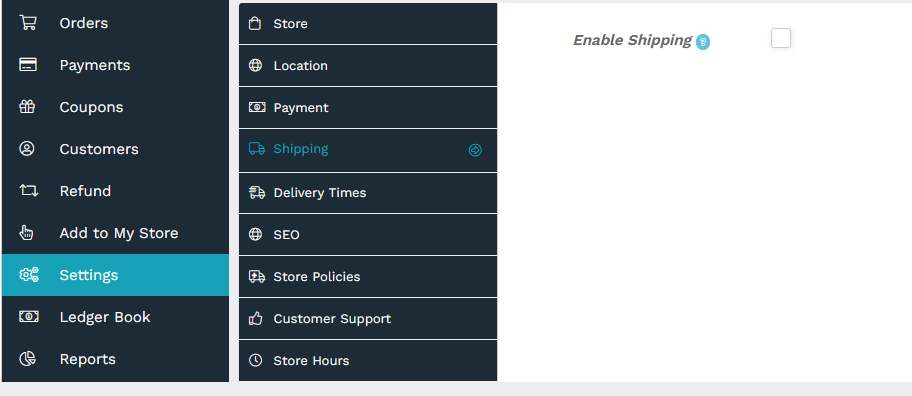
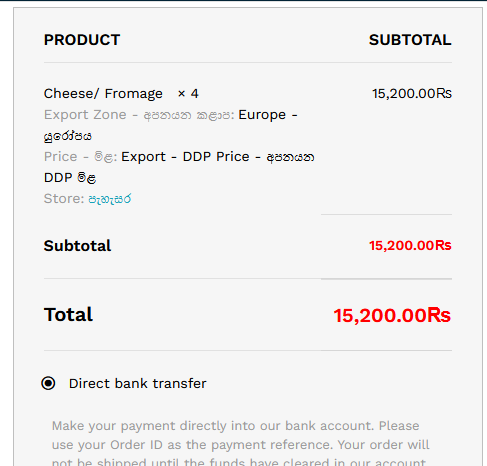
Versand & Verteilung
- Versand per Entfernung
- Versand nach Gewicht
- Versand nach Land
- Versand nach Zone
- Sie können alle Zahlen für jede Methode auf einmal einstellen, sollten jedoch nur EINE STANDARD- Versandart für die Zahlung verwenden. Bedeutet, wenn Sie alle Einstellungen und die ausgewählte Entfernung als Standardmethode speichern, können Sie nicht unter “Länderversand” exportieren. Dazu müssen Sie unter den Versandeinstellungen die Standardmethode “Versand nach Land” auswählen.
- Es gibt kein automatisches Wechselsystem zwischen den 4 Versandarten, daher müssen Sie die Standardeinstellung manuell für eine andere Versandoption auswählen.
Z.B;
Standardmethode speichern – Entfernung ( Sri Lanka)
Kunde – aus einem anderen Land (USA) → Daher muss die Standardversandart “Versand nach Land” ausgewählt werden.
Wenn Sie Schwierigkeiten bei der Versandeinstellung haben, richten wir es kostenlos für Sie ein. Sie müssen uns alle Details in schriftlicher Form mitteilen.

- Möglicherweise müssen Sie Versandmethoden nur einmal einrichten, später können Sie die Zahlen bei Bedarf ändern.
- Die Einstellungen für den lokalen Vertrieb und den Exportversand werden in einem einzigen System auf unserer Plattform vorgenommen und Sie können die am besten geeigneten Versandmethoden festlegen.
- Sowohl der lokale Vertrieb als auch der Export werden unter dem Namen ‘Versand’ in unserem Dashboard und der Zahlung an der Kasse angezeigt .
- Alle Einstellungen können über das System-Dashboard angepasst und automatisch separat in der Kassenzahlung der Schlussrechnung hinzugefügt werden.
- Anbieter-Dashboard -> Einstellungen -> Versand -> Versand aktivieren -> Wählen Sie Versandart.
- Der Versand kann auch unter Ihrer Produktspezifikation angegeben werden (Spezifikation = Attribute).
- Bearbeitungszeit – Wie viele Tage dauert die Herstellung der Produkte.
- Versandklasse – Versandklassen sind die Gruppe ähnlicher Produkte, die nach Produkttypen wie Class 50, Class 65, Class 92.5, Class 125 usw. versendet werden können.
- Verwenden Sie die Schaltfläche „Speichern“, bevor Sie zu anderen Einstellungen wechseln.
- Wenn Sie sich bei der Aktivierung der Versandeinstellungen nicht sicher sind, senden Sie bitte eine interne Nachricht in schriftlicher Form mit Details, wir werden dies für Sie beheben.

01). Entfernungstarif Versand
Dies beinhaltet die Berechnung der Versandkosten basierend auf der Entfernung des Verkäufers. Die genaue Entfernungsberechnung erfolgt über ‘GPS – Google Map’ und ermittelt den Preis für den nächstgelegenen Standort des Käufers.
Wenn Sie den Standort an einigen Stellen nicht über Google Maps finden können , werden Sie auf die nächste Stadt oder das nächstgelegene Dorf verwiesen. In solchen Fällen sollten sowohl der Käufer als auch der Verkäufer die nächstgelegene platzieren.
Um mit dem Standort des Versanddienstleisters zu arbeiten, ist es wichtig. Stellen Sie also sicher, dass Verkäufer ihren Standort auf der Karte angeben müssen. Einstellung -> Standort.
- Serviceaktivierung – Versand aktivieren
- Produktbearbeitungszeit – Zeit, die benötigt wird, um das Produkt zu verarbeiten.
- Versandart – Trinken nach Entfernung
I. Standardkosten:
Die Standardkosten sind die anfänglichen Liefer- oder Versandkosten aller Produkte im Rahmen des Versands per Distanz. Wenn Sie keine weiteren Kosten haben, sind dies die Grundkosten der Lieferung, wenn noch weitere Kosten anfallen, fallen diese wie folgt an;
II. Maximale Entfernung
Wenn Sie eine Lieferung durchführen, können Sie den Preis für die maximale Entfernung festlegen, die Sie liefern.
Hinweis: Wenn Sie hier die maximale Entfernung angeben, können Käufer außerhalb dieses Limits nicht kaufen und die Zahlung wird nicht zugelassen.
Wenn Sie nicht über die maximale Entfernung verfügen, können Sie das Feld leer lassen und dann kann jeder Produkte aus jeder Region oder jedem Land kaufen.
Wenn Sie in Städten unterschiedliche Kilometer liefern, dann verwenden Sie hier die Methode ‘Distanzkostenregel’.
III. Kostenloser Versand Mindestbestellmenge:
Die Mindestanzahl von Einheiten, die für die kostenlose Verteilung erforderlich ist.
NS. Lokale Abholkosten aktivieren:
Kosten für die Beschaffung von Produkten beim Verkäufer.
Distanz-Kosten-Regeln:
Dies summiert sich zu den Standardkosten. Wenn Sie dies nicht möchten, können Sie diese Optionen leer lassen. Andernfalls können Sie die Standardkosten leer lassen und die Entfernungskosten mithilfe von zwei Optionen anpassen.
- Entfernung bis
- Entfernung mehr als
Anhand dieser Tabelle können Sie die Versandkosten nach Entfernungsabweichungen anzeigen.
Ex:
Bis zu 10 Km – 50 (Rupien)
Mehr als 100 Km – 200 (Rupien)
Mehr als 400 Km – 500 (Rupien)
Fernversand an der Kasse #
- Um den Versand basierend auf der Entfernung zu berechnen, müssen Benutzer ihre standortbezogene Karte auf der Checkout-Seite einfügen.
- Sobald Benutzer ihren Standort eingeben, werden die Versandkosten berechnet und angezeigt.
- Wenn der Standort des Benutzers mehr als die vom Verkäufer zu liefernde „Max Distance“ ist, wird eine Fehlermeldung angezeigt und die Bestellabwicklung wird blockiert.
- Siehe das Bild.
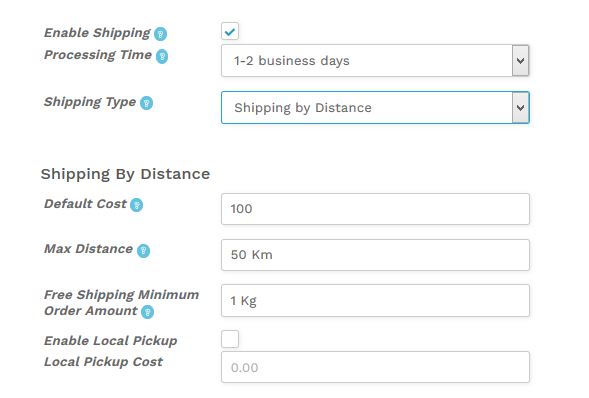
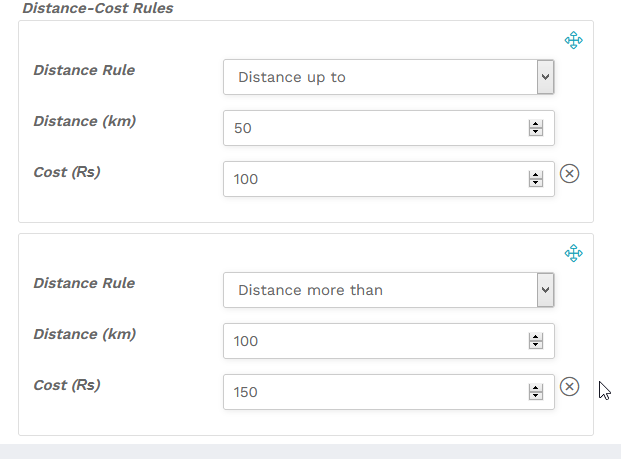


2). Versand nach Gewicht
- Versand aktivieren – Klicken Sie hier, um den Versand einzurichten und zu aktivieren.
- Bearbeitungszeit – Nehmen Sie sich vor dem Versand Zeit für die Produktion.
- Versandart – Versand nach Gewicht
- Kostenloser Versand Mindestbestellmenge – Wenn der Verkäufer nach einer bestimmten Anzahl von Bestellungen kostenlosen Versand anbietet.
- Lokale Abholung aktivieren – Wenn der Verkäufer dem Käufer erlaubt, seinen Platz zu besuchen und Waren mitzunehmen.
Berechnung der Versandkosten nach Land und Gewicht
- Land: Land des Käufers
- Kosten berechnen: Zwei Möglichkeiten
-
Berechnen Sie die Kosten basierend auf Regeln:
Wenn der Benutzer Regeln für die Berechnung festlegt, erhält er die folgenden Optionen wie gezeigt.
- Länderstandardkosten, wenn keine Abgleichsregel vorhanden ist – Wenn es für alle Länder Standardkosten oder Fixkosten gibt, kann der Verkäufer diese im Allgemeinen hier platzieren.
Gewichtungskostenregel;
Auswählen;
- Gewicht bis
- Gewicht mehr als
Anhand dieser Tabelle können Sie die Versandkosten nach Gewichtsabweichungen anzeigen.
- Gewicht:
Die Gewichtsmenge kann hier in kg eingegeben werden.
- Kosten:
Hier kann der Verkäufer die Kosten hinzufügen.
2. Berechnung auf Basis pro Einheit:
Wenn der Benutzer entscheidet, Regeln auf Einheitsbasis festzulegen, erhält er die folgenden Optionen wie gezeigt: Sobald die Kosten pro Einheit ausgewählt sind, wird der Benutzer aufgefordert, die Kosten einzugeben, die pro kg hinzugefügt werden.
Beachten Sie, dass der Benutzer durch Klicken auf die (+)-Symbole weitere Länder hinzufügen und Regeln festlegen kann.
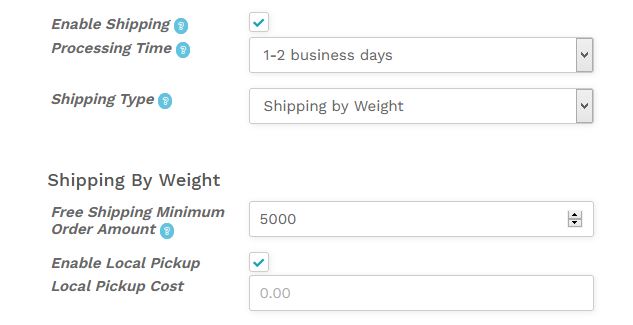


03). Versand nach Land
In den Einstellungen “Versand nach Land” können Verkäufer 4 verschiedene Arten von Standardkosten festlegen.
- Standardversandpreis:
Dies ist der Basisversandpreis für alle Produkte des Verkäufers, unabhängig von Ländern und Staaten.
2. Zusatzpreis pro Produkt:
Diese Kosten fallen für jeden zweiten Produkttyp desselben Anbieters im Warenkorb an.
3. Pro Menge zusätzlicher Preis:
Diese Kosten werden auf jede zweite Menge desselben Produkts des Verkäufers angewendet, die sich im Warenkorb befindet.
4. Kostenloser Versand Mindestbestellmenge:
Der hier eingegebene Betrag ist der Richtwert, ab dem der Versand kostenlos ist.
Versandberechnung:
- Versand aus: Das Land, aus dem der Verkäufer Produkte versendet.
- Versandkosten nach Land; Land des Käufers.
- Kosten – Preis, der irgendwo in das Land des Importeurs gehört
- Versandkosten nach Bundesland; Gesamtkosten bis zum entsprechenden Bereich. Dies muss nicht ausgefüllt werden, es sei denn, die Kosten variieren je nach Region des Landes.
- Die oben genannten Optionen ermöglichen es den Anbietern, die Versandkosten für bestimmte Länder und deren korrelierte Staaten festzulegen.
Verkäufer können den Versandpreis für jedes Land festlegen, indem sie den Ländernamen aus jeder Dropdown-Liste auswählen. Die Anzahl der Länderauswahlfelder kann durch Anklicken des Pluszeichens ‘+’ am unteren Rand des Länderauswahlfeldes erhöht werden.
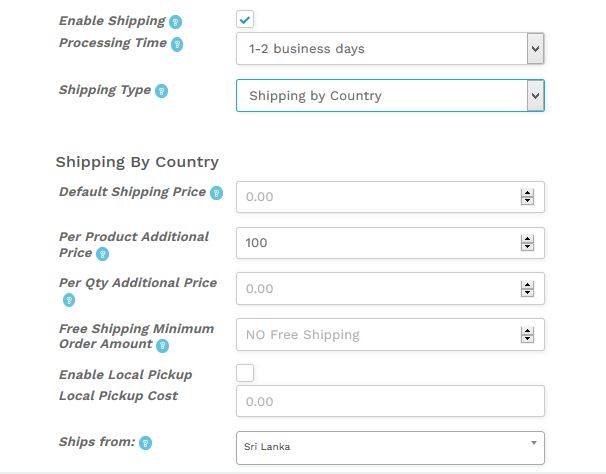
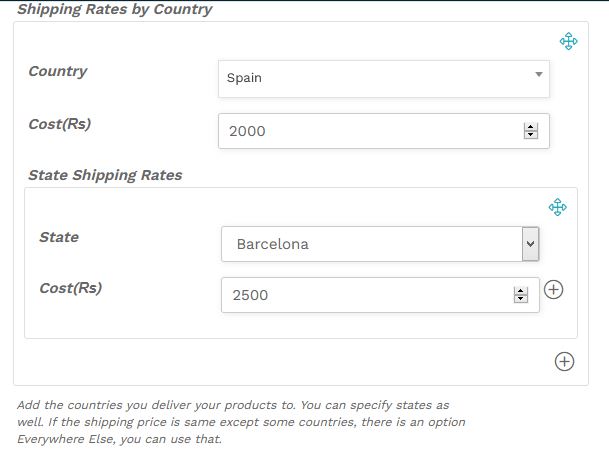
04). Versand nach Zone
-
Sie können unterschiedliche Vertriebspreise für verschiedene Regionen festlegen, dazu müssen Sie ‘Versand aktivieren’ auswählen.
-
Die Preise können je nach Größe, Anzahl der Produkte, Maximalgröße usw. variieren.
- Bei dieser Methode haben Sie 03 Verteilungstypen.
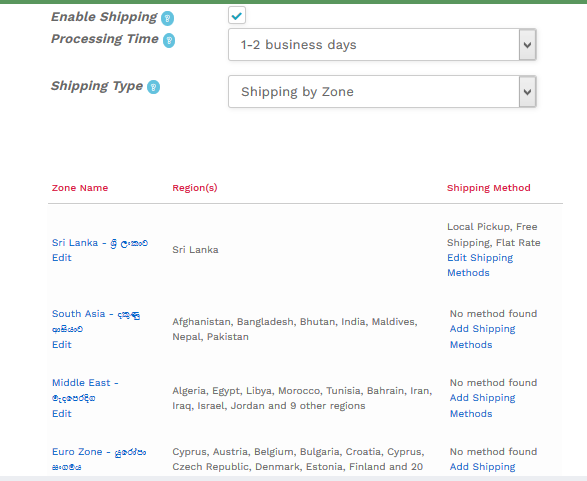
Versandmethoden hinzufügen
Um Versandmethoden hinzuzufügen, müssen Verkäufer “Versandmethode” hinzufügen und dann auf die Option Bearbeiten klicken:
-
Methodentitel Status Beschreibung Lokale Aufnahme
Bearbeiten | LöschenLieferung nur am Wochenende Kostenloser Versand
Bearbeiten | LöschenInformieren Sie sich im Voraus, um den besten kostenlosen Versand zu erhalten Flatrate
Bearbeiten | LöschenDie Rate ändert sich nach verschiedenen Merkmalen, wie Menge, Anzahl der Produkte, Mindestmenge, Höchstmenge usw.
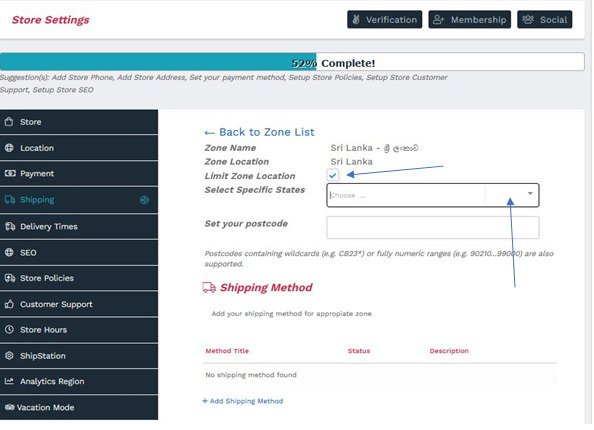
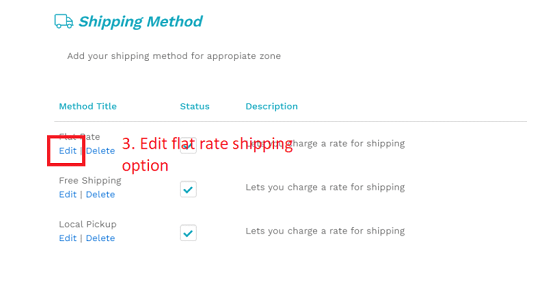
Nachdem Sie auf ‘Bearbeiten’ geklickt haben, haben Sie ein folgendes Menü.
A. Lokale Aufnahme
B. Kostenloser Versand
C. Flatrate
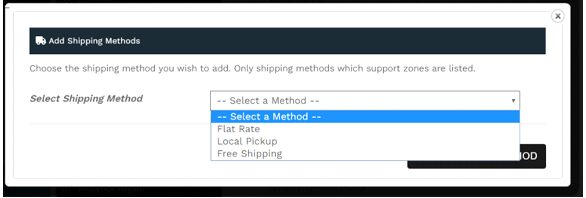
1. Versandkostenpauschale:
Hier können Sie einen Standardpreis pro Artikel, pro Versandklasse oder pro Bestellung definieren. Einfach ist es ein variabler Preis nach Menge.

Lassen Sie uns die obigen Felder kurz besprechen:
- Methodentitel: Geben Sie einen Titel ein, der den Kunden im Checkout angezeigt wird.
Kosten:
Verkäufer können diesem Feld zusätzliche Kosten pro Artikel hinzufügen. Dieses Feld kann leer gelassen werden, um die Pauschale zu deaktivieren, außer wenn Kosten für Versandklassen hinzugefügt werden. Beachten Sie, dass Ihre Eingaben die Gesamtkosten im Abschnitt Versandklassen berücksichtigen können, es sei denn, es wird leer gelassen.
Im Folgenden sind die Platzhalter aufgeführt, die bei der Eingabe der Kosten zu beachten sind: Sie können dem Schritt folgen, um die entsprechenden Versandkosten einzugeben.
Steuerstatus – Legen Sie fest, ob auf den Versandbetrag Steuern erhoben werden.
Beschreibung: Sie können die Beschreibung des Tarifs in das Feld eingeben.
Im Folgenden sind die Platzhalter aufgeführt, die bei der Eingabe der Kosten zu beachten sind:
[qty] – Anzahl der Produkte im Warenkorb
[fee] – Eine zusätzliche Gebühr. Diese Gebühr hat zwei optionale Argumente.
Prozent – Ein Prozentsatz basierend auf den Gesamtauftragskosten.
min_fee – Ein Mindestbetrag. Nützlich bei der Verwendung von Prozentsätzen.
max_fee – Ein Höchstbetrag. Nützlich bei der Verwendung von Prozentsätzen.
- Format 1: 10,00 * [qty]
- Format 2: [fee percent=”10″ min_fee=”20″ max_fee=””]
- Format 3: 15 + [fee percent=””5″” min_fee=””2″”]
-
Basierend auf der Menge
[qty] – Anzahl der Produkte im Warenkorb.
Format 1: P * [qty]
- 20 + ( 3 *[qty] ) – Grundversandkosten von 20 USD plus 3 USD für jeden Artikel im Warenkorb.
2. Basierend auf einem Prozentsatz (%) – Ein Prozentsatz basierend auf den Gesamtbestellkosten.
[fee] – Eine zusätzliche Gebühr. Diese Gebühr hat zwei optionale Argumente.
- min_fee – Ein Mindestbetrag. Nützlich bei der Verwendung von Prozentsätzen.
- max_fee – Ein Höchstbetrag. Nützlich bei der Verwendung von Prozentsätzen.
Beispiel:
- 15 +[fee percent=””5″” min_fee=””2″”] – Grundversandkosten von 15 USD plus 5 % der Gesamtbestellmenge, was mindestens 2 USD entspricht. Bedeutet, dass der Käufer im Warenkorb bezahlen muss; Kosten + Versand, $15 + $2 = $17
Kosten der Versandklasse:
Wenn Sie Versandklassen haben, fügt die Schnittstelle einige weitere Felder hinzu, wie im obigen Bild gezeigt. Diese Kosten können optional basierend auf der pro Produkt eingestellten Versandklasse eingegeben werden (Diese Kosten werden zu den oben genannten Versandkosten hinzugerechnet).
- Kosten der Versandklasse „X“
Geben Sie die Kosten für eine bestimmte Versandklasse ein.
- Keine Kosten für die Versandklasse
Nützlich, wenn Sie die Option Pro Klasse verwenden. Verwenden Sie andernfalls das Feld Kosten.
Berechnungstyp
Dies hat zwei Möglichkeiten:
- Pro Bestellung – Wählt die teuerste Option basierend auf den Versandkosten im Warenkorb aus.
- Pro Klasse – Gebühren für den Versand für jede Versandklasse.
Immer ‘SPEICHERN’, um eine Methode zu aktivieren, die dazu führt, unsere Seite zu überprüfen.
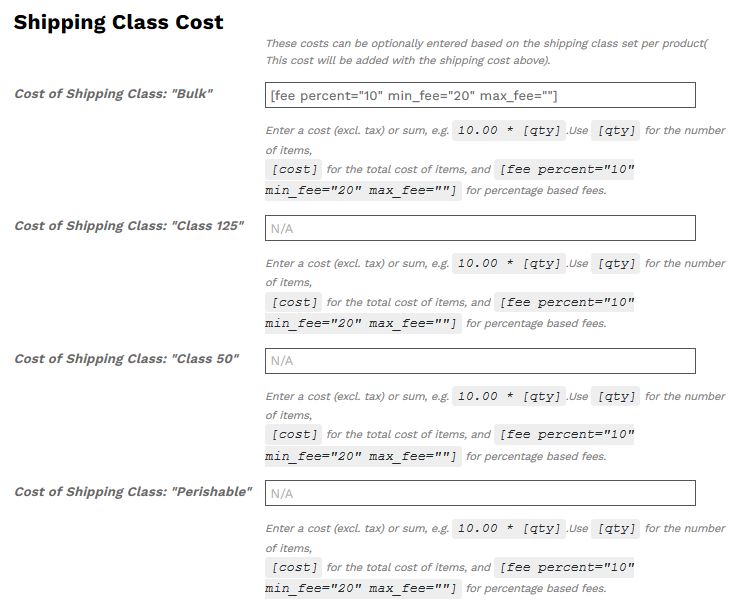

2. Kostenloser Versand
Diese Versandart gibt dem Verkäufer einige spezifische Mindesteinheiten für den Versand. Wenn der Käufer eine Mindestmenge kauft, kann der Verkäufer versandkostenfrei machen.
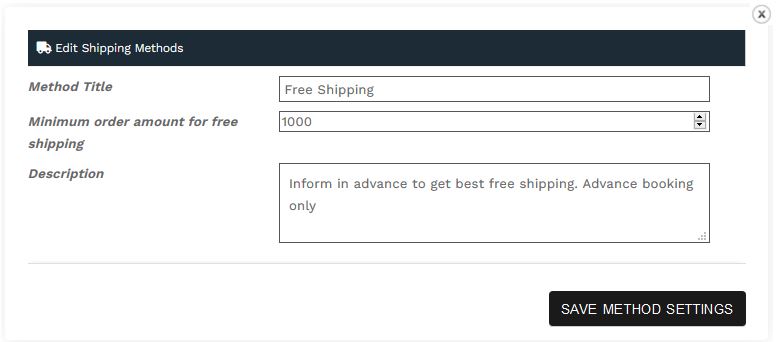
3. Abholung vor Ort
Lokale Abholung ist eine Methode, die es dem Kunden ermöglicht, die Bestellung in den Räumlichkeiten des Verkäufers selbst abzuholen. Der Verkäufer kann hier die relativen Steuern und Kosten konfigurieren. Auf diese Weise kann der Verkäufer die lokalen Abholoptionen für sein Geschäft konfigurieren. Wenn keine Kosten anfallen, können Sie Null setzen.
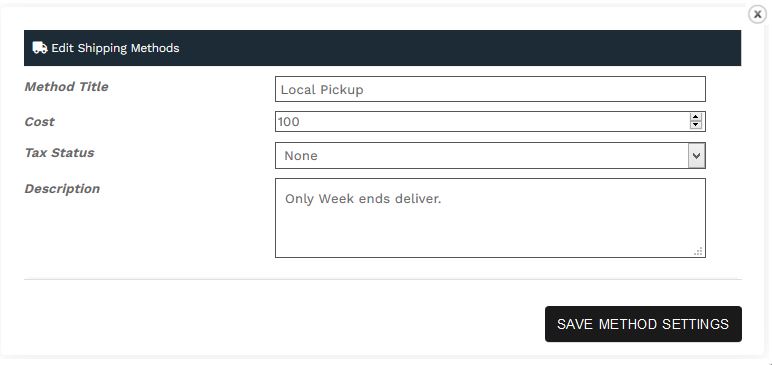
Teil 2
Exportverfahren
Export Process steps
- 1. Obtaining License
- If there is an individual or an institution that wants to export goods directly from any country to another country, it is required to register with the relevant government agencies in that country.
- If you are not a direct exporter or company, you can deliver your goods to the relevant courier company or export company. They transport goods from your home or place of business to the importer's place.
- If you live in Sri Lanka, this link will help you register; https://www.srilankabusiness.com/pdf/export-procedure-21-10-2014.pdf
- 2. Goods Order/ Proforma Invoice
- The export process usually begins with the buyer's order request.
The buyer who wishes to buy the goods from the other country sends an inquiry relating to price, desired quality, terms, and conditions for the export of goods which is known as Trade inquiry/order. - The exporter sends a 'quote' in response. The form that contains information about its selling price, quantity, quality, distribution method, etc. is called 'Proforma Invoice'.
- A proforma invoice is an initial bill or estimate invoice that is the first bill issued by the exporter to request payment from the dedicated buyer for the goods or services before it is delivered. The price is not yet agreed so it is not a true invoice.
- Your buyer will need a proforma invoice to arrange the finances and open a letter of credit.
- The export process usually begins with the buyer's order request.
- 3. Methods of Payment /Letter of Credit (LC)
- After sending the proforma invoice, the exporter demands a Letter of Credit (L/C) from the importer.
- Then importer should request from his bank to issue a Letter of Credit in favor of the exporter’s bank.
- Through the (L/C), the buyer's bank gives assurance to the exporter of accepting the bill of exchange of a certain amount.
- If required, the exporter can ask for advance payment or full payment also from the importer under this.
Notification
- If you are paying through gewattha.com you can use PayPal instead of this L/C. The importer then pays to Gewattha.com and the exporter wants to export the relevant goods.
- The advantage here is that the transaction can be done quickly and easily at any time from anywhere and there are no bank fees.
- The importer's cash is retained in PayPal.com until the exporter delivers the goods to the importer.
- If the exporter fails to send the goods, the money will be refunded to the importer.
- 4. Find a Freight Forwarder or Courier Service
- If your goods are ready for delivery, then you need to find a Freight Forwarder or Courier company to export your goods. They may seem similar, but freight companies and couriers take very different approaches to how they move packages.
- Both freight forwarders and couriers can provide delivery solutions for your items but this is based on products, time, cost, distance, and quantity.
- 5. Export Documents
- Exporters should seriously consider having the right freight forwarder to handle the amount of documentation.
- The following documents are commonly used in exporting; which of them are actually used in each case depends on the requirements of both our government and the government of the importing country.
- You may not require all documents based on your products, your courier company will inform & handle many documents on behalf of you.
- Commercial invoice
- Dock receipt
- Bill of lading
- Certificate of origin
- Warehouse receipt
- Inspection certificate
- Export license
- Packing list
- Health certificate
- Insurance certificate
- 6. Shipment Advice to the Importer
- The exporter sends shipment advice to the importer of the goods so that the importer gets informed about the dispatch of the goods.
- The exporter sends a copy of the packing list, a non-negotiable copy of the Bill of Lading, and commercial invoice along with the advice note.
- 7. Exporter Presentation of Documents to the Bank
- The next step for the exporter is to submit the relevant documents to the bank. This process is initiated to receive the payment from the importer’s bank account.
- The documents required to be submitted to the bank for receiving the payment are often referred to as the ‘Negotiable Set of Documents’. The process initiated by the exporter’s bank with the importer’s bank after receiving the Negotiable Set of Documents is commonly called the ‘Negotiation of the Documents’.
It is obligatory for you that after shipping the goods, you must hand over the relative documents within 21 days of shipment to your bank for onward despatch to the overseas correspondent bank.
The legal requirement is that the payment against exports should be realized through an authorized dealer in foreign exchange (Bank) within six months of the date of shipment.
- The following documents may generally need to be submitted to the exporter’s bank for initiating the process of payment realization:
- Commercial Invoice
- Bill of Lading
- Certificate of Origin
- Dock Receipt
- Inspection Certificate
- Insurance Certificate
- Export Packing List
- 8. Bank To Bank Documents Forwarding
- The negotiating Bank will execute the shipping documents and forward them to the Banker of the importer, to enable him to clear the consignment.
This process will be conducted as per the terms and conditions of the LC of the importer.
The bank then issues a bank certificate and attested copy of the commercial invoice to the exporter.
- 9. Generation of Bill of Exchange
- A Bill of Exchange is generated after consideration of the documents mentioned above, and is commonly known as the ‘Documentary Bill of Exchange’. This Bill of Exchange can be of two types.
Sight draft:
If the funds are to be paid immediately or on-demand.
Usance draft:
A time draft gives the importer a short amount of time to pay the exporter for the goods after receiving them.
Realisation of payment
- After the importer’s bank receives the documentary Bill of Exchange, it releases the funds for payment. Payment is released in both cases of sight draft or usance draft.
- The exporter’s bank receives the payment from the importer’s bank, and the account of the exporter is credited.
- Authorized dealers will issue Bank Certificates to the exporter, once the payment is received, and only with the issuance of the Bank Certificate, the export transaction becomes complete.
- 10. Customs Goods Declaration
- Clearance of goods is a statement expressing the terms and conditions described by Customs. It shows the customs procedure to be applied by the persons concerned (importer/exporter or agent) on the goods.
- These documents have to be submitted together with the declaration to Customs, and are therefore referred to as supporting documents such as the commercial invoice (e.g. for the invoice amount, seller and buyer), the transport document (e.g. for the consignor, consignee, means and mode of transport) or the certificate of origin, or that have to be submitted as proof of specific import/export conditions being met (e.g. import/export permits, health certificates and certificates of conformity with technical standards).
Teil – 3
Nützliche Export- und Importdokumente
Following Export & Import Documents May Require.
- 1. Bill of Lading
- A bill of lading is a contract issued by a carrier (shipping company) or its agent to the owner of the goods, confirming that the goods have reached an acceptable condition and are ready to ship.
- The bill of lading acts as a title of ownership of goods throughout the process of shipping, transportation, and receiving, the bill of lading is the sole proof of transaction. This legal document protects the shipper, the carrier, and the customer all in one place.
- The exporter needs a copy of the bill of lading to hand over to the bank if payment is done in a letter of credit.
- A bill of lading is a standard-form document that is transferable by endorsement.
Importance of the Bill of Lading Form
1.Evident of Shipment or Carriage:
The contract of carriage entered into between the “Carrier” and the “Shipper or Freight Owner” in order to carry out the transportation of the freight as per the contract between the buyer and the seller.
2. Receipt of Goods:
A BOL is a document that verifies that goods have been received by an agent, carrier, (3PL Third-party logistics), or others from one party. When this occurs, in most cases, the organization that takes possession of the commodity is responsible for its condition. The BOL provides a paper trail of evidence to support freight damage claims.
3. Title Documentation:
This essentially means that whoever holds the bill of lading has the title for possession or ownership of the goods.
- The following is the information that must be included:
*Names and addresses:
The full names and addresses of both the shipper and receiver (consignee).
*Purchase orders
Any special order tracking numbers can include as a reference number.
*Special instructions:
Here is where you will note instructions for the carrier that are not extra service requests like liftgate or delivery notification.
* Date:
This is the pickup day, and it may be needed as a reference to track your freight or when you reconcile shipping invoices.
*Description of items:
The shipper will verify with the carrier the type of packaging (such as cartons, skids, pallets, drums, or containers), the quantity of packaging or shipment units, the amount of space it takes in the shipping container, or platform, and the dimensions.
*NMFC freight class:
Classes are an industry standard for the transportation of goods. They are based on NMFC tariffs and are a publication for motorists that includes rules, descriptions, and ratings of all products. It is divided into 18 classes of shipping.
*Department of Transportation hazardous material designation:
Hazardous shipments must be clearly cited and special rules and requirements apply when shipping.
*Declared Value:
The declared value for courier is equal to the cost of purchase of the item.
The declared value for customs i.e price at which the item is sold.
Customs use this value to clear your shipment and determine taxes and duties. Additionally, your commercial invoice should have the HS value and a detailed description of your shipment. If any of the information is inaccurate, your package will be held at the customs or courier services.The following acronyms can also include details around the bill of lading:
OBL: Ocean bill of lading.
AWB: Airway bill of Lading. - 2. Bank Draft
- Usually the seller’s bank will send the bank draft and related documents via the freight forwarder to the buyer’s bank.
- When the buyer authorizes payment for the goods, the bank releases the documents to the buyer and transfers the funds to the seller’s bank.
- There are two drafts; a sight draft requires an immediate payment while time drafts allow the importer to pay at a later date.
- 3. Certificate Of Origin
- It certifies that goods in a particular export shipment are totally obtained, produced, manufactured or processed in a particular country. They declare the ‘nationality’ of the product and also serve as a declaration by the exporter to satisfy customs or trade requirements.
- COs are requested by customs, banks, private stakeholders and importers for several purposes. Almost every country in the world requires CO for customs clearance procedures: when determining the duty that will be assessed on the goods or, in some cases, whether the goods may be legally imported at all.
The proof of review usually amounts to the chamber’s official embossing stamp and a signature of an authorized chamber representative. Some countries are accepting electronically issued certificates of origin that have been electronically signed by a chamber of commerce.
The product may be marked ' Made in Sri Lanka "Made in the USA" or "Made in China"
- Free Trade Agreements (FTA) with other countries don’t typically require a specific form to be used as proof of origin. Instead, they identify the information that must be included on a certificate of origin or some other document like the commercial invoice to prove that the goods qualify for preferential duty rates.
- 4. Commercial Invoice
- A commercial invoice is a contract and proof of sale issued by the seller to the buyer. This document describes the goods for sale and describes the price, value, and quantity of the goods. The commercial invoice is used by customs to calculate and assess customs duties and taxes payable on shipping.
- A commercial invoice is prepared to contain information about the buyer, the freight forwarder, the customs broker, the C&F agent, and the shipping to the bank. It is mandatory for all sea freight, air freight, and incoterms shipments. There is no specific format for creating an invoice. However, it should contain all the basic details of the transaction.
- A properly completed and correct commercial invoice for export helps customs authorities quickly decide which taxes and import duties apply to your package.
- A complete and accurate commercial invoice is indeed a legal requirement. Failure to do so may result in long customs delays and potential charges. Furthermore, providing incorrect information about a customs invoice can lead to lower payments on customs and taxes, which can have legal implications.
Commercial Invoice Checklist for Exports
Transaction Information
• Currency
• Instructions of payment
• Invoice data
• Invoice number
• Order number
• Sale totalExporter and Importer Information
• Exporter/Seller’s tax ID number (VAT, EORI)
• Exporter/Seller's name address, phone number
• Importer/Buyer’s name, address, phone number
• Importer/Buyer’s tax ID number (VAT, EORI)
• Notify party’s informationShipping Information
• Bill of Lading number
• Description of goods (number of packages, units, weight)
• Exportation date, mode of transport, and final destination
• Forwarding agent
• Harmonized System (HS) code
• Incoterms
• Insurance
• Origin of goods
• Shipper’s signature - 5. Dock Receipt
- A dock receipt is a receipt issued by a shipping company as proof of receiving the goods for shipment. A dock receipt ensures the carrier is accountable for the safe custody of the good until it is delivered to the destination. The bill of lading is prepared based on the dock receipt.
- The ocean carrier booking number in your dock receipt is the key number during all international cargo transportation. All the information related to your shipment connects to the booking number.
- If you utilize a third-party trucking company such as FedEx Ground, DHL Ground, etc., ensure that the carrier's booking number is the key number in your delivery order.
- This Suits for damages in the case of lost, missing, stolen, and damaged merchandise will require people to sift through the receipts, bills of lading, and other documentation to see when the problem developed and who was responsible for the shipment while the incident occurred.
- Standardized dock receipt forms are available from a number of companies involved in the shipping industry.
Warehouse Receipt
- After an individual or company drops of their goods at a warehouse or dock, they are given a receipt called warehouse receipt. A warehouse receipt is to ensures the quality and quantity of a particular commodity stored within an approved facility.
Warehouse receipts list the types, numbers, and other identifying characteristics of the stored goods. - The warehouse operator who has custody of the stocks guarantees delivery against the receipt and should be able to make good any value lost through theft, fire, or other issues.
- 7. Export Packing List
- A packing list is produced by the seller primarily for the use of the buyer, it contains information about the contents of the exported goods.
- The document will typically state a number of details relating to the shipment including how they have been physically packed, it is needed to generate the Bill of Lading. Simple mistakes of this document may result in unnecessary delays and their corresponding fees.
1 – Details of the exporter/consignor
- The full name, address, and contact details of the seller.
2 – Consignee & Buyer (if not Consignee)
- The full name, address, and contact details for the buyer
3 – Shipping Details
- Country of Final Destination.
- Country of Origin.
- Letter of Credit No (if goods are sold under a Letter of Credit).
- Marine Cover Policy No (if applicable).
- Method of Dispatch – Road, Rail, Air, or Sea Freight.
- Port of Discharge (POD).
- Port of Loading (POL).
- Type of shipment – FCL, LCL, Breakbulk, or other.
- Vessel / Aircraft Name.
- Voyage Number.
4 – Reference Numbers
- Invoice number
Sales order number. - Purchase order number.
- Any other reference number.
5 – Product Details
• Currency of transaction
• Description of goods
• HS Code
• Incoterm
• Price (per unit type)
• Product Code
• Unit Quantity
• Unit Type6. Marks and Numbers
- Identify any special marks, codes, numbers and so forth that may appear on your package. Number of Packages Enter the total number of packages, cartons, or containers for this shipment.
- All companies involved in the transport of your cargo (manufacturer, shipper, customs, carriers, warehouses, consignees, etc.) trust on the respective marks and numbers to distinguish it from all others
- This can and does often show as ‘Fully Addressed’ to represent.
7 . Type of packaging used.
- Wooden box, drums, corrugated carton boxes, pallets.
- The dimensions of each piece.
- The net weight and the gross weight for each piece.
8. Authorized Signatory
- Dated and stamped, affixes a stamp of authenticity to the packing list.
- 8. Health Certificate
- An Export Health Certificate (EHC) is a document used in export transactions, issued by the governmental organizations at the countries of origin, to certify that a food shipment is fit for human consumption, and meets safety standards or other required legislation for exporting.
- All food products which are subject to international trade, whether of animal or non-animal origin, must be fit for human consumption and comply with all relevant food standards such as hygiene, pesticides, genetic, labeling, contaminants, use of additives/preservatives, etc.
Following Products, you need an export health certificate (EHC) or other certificates to export or move:
- Processed food and drink
- Food or drink that contains products of animal origin (POAO)
- Vegetables, fruit, and other plants are used as food.
- Meat
- Dairy (milk, yogurt, cheese, butter & ice cream)
- Hides, skins, wool, feathers & lanolin
- Collagen, Gelatine, honey & animal casings
- Egg
- Fish and fishery products
- Pet food and animal feeds
- 6. Export License
- An export license is a document issued by government bodies allowing registered companies or individuals to legally ship goods that are otherwise restricted.
- The application process for an export license varies for each country. You can find out what you need to do on your country’s government website.
- Once you’ve received the export license, you need to include the export license number on the commercial invoice when shipping your goods.
- 9. Inspection Certificate
- Sometimes called a certificate of inspection or pre-shipment inspection certificate, an inspection certificate provides proof that what you are shipping is, in fact, what the customer ordered, and is also of good quality.
- The Certificate of Inspection is an inspection report or report of findings and is required by some importers or importing countries.
- The third-party inspection company issues inspection certificates after inspection and when the goods are shipped to the buyer's premises. There are well-known International Inspection Companies that carry out these activities.
- Generally, LC’s mandate the inspection certificate issued after the B/L (Bill of Lading).
- It is precipitated by the request for a Letter of Credit payment transaction that indicates an inspection certificate is required in order to fulfill payment obligations.
The following items are included in the content of the certificate of Inspection:
- Applicant :(The name of buyer company which has opened the LC).
- Consigned to the Order; The name of the LC opened bank or buyer bank’s.
- Beneficiary: (The name of the seller).
- LC No. and LC Date
- Custtom Tariff Code No.
- Proforma Invoice No. and Date
- Purchase Order No. and Date
- Insurance Policy No.
- Country of Origin
- Place of Inspection
- Date of Inspection
- Scope of Inspection
- Port of Discharge
- Type of Packing
- Number of Packages
- Description of Goods (with reference to the packing list number and Date)
- Bill of Lading No. and Date
- Gross weight
- Conclusion (as per LC, 46.A clause , if even there is syntax error in the LC should not be corrected)
- Name and Signature of Authorized Person
- Place and Date of Issue
- 10. Insurance Certificate
- Certificates of Insurance cover the importer/exporter for any possible damage to the goods while in transit. It contains details such as the insurance company, limits of coverage, policy number, consignee, and valid period for the policy.
- Your broker or freight forwarder can arrange insurance for your shipment.
Loss and Damage Claim
- Exporters use this form to claim insurance compensation for goods lost, damaged & delays during exportation. The claim must fully describe lost items and supporting documents, copies of documents necessary to support an insurance claim include the insurance policy or certificate, bill of lading, invoice, packing list, and a survey report (usually prepared by a claims agent).
- 11. Letter Of Credit (LC)
- A Letter of Credit (LC) is a document that guarantees the buyer’s payment to the sellers. It is issued by a bank and ensures timely and full payment to the seller.
- If the buyer is unable to make such a payment, the bank covers the full or the remaining amount on behalf of the buyer.
- The bank charges fees and commissions for playing the part of an intermediary.
- The fees required for LCs will depend on a variety of factors, including the risk associated with the contract, as well as the specific type of LC needed.
- An interest rate is usually established based on the amount involved and how long the buyer has to wait before receiving the goods.
- A percentage of the invoice value underwritten in charged, which is from 0.1% to 2.0% of the commercial invoice value per month.
- Who will pay the charges and will be mentioned in the charges clause of the LC. Mostly both parties agree that charges inside the countries of the applicant will be paid by the applicant and bank charges outside the applicant’s country will be paid by the beneficiary.
Buyer pays L/C Issuing commission, opening fee, advising fee and Transmission charges.
Seller pays L/C Advising Charge, amendment fees, discrepancy fees, etc.
Parties to a Letter of Credit
1. Applicant (importer) requests.
2. Issuing bank/Opening banker (importer’s bank).
3. Beneficiary (exporter).
Common types of letters of credit
- Revocable
A revocable letter of credit is uncommon because it can be changed or cancelled by the bank that issued it at any time and for any reason.
2. Irrevocable
An irrevocable letter of credit cannot be changed or cancelled unless everyone involved agrees. Irrevocable letters of credit provide more security than revocable ones.
3. Confirmed
A confirmed letter of credit is one to which a second bank, usually in the exporter’s country adds its own undertaking that payment will be made. This is used when the exporter does not find the security of an unconfirmed credit sufficient due to issuing bank risk or political and/or economic risk associated with the importer’s country. Only irrevocable LC can be confirmed, so a confirmed letter of credit provides more security than an unconfirmed one.
4. Unconfirmed
An unconfirmed letter of credit is one which has not been guaranteed or confirmed by any bank other than the bank that opened it. The advising bank forwards the letter of credit to the beneficiary without responsibility or undertaking on its part but confirming authenticity.
5. Back-to-back letter of credit
A broker or a financial institution can act as an intermediary between the buyer and seller. In such case, one letter of credit is issued to the intermediary. Two letters of credit (LCs) are involved in a back-to-back letter of credit transaction.The intermediary then secures a second letter of credit to complete the transaction. One is given to the intermediary and issued by the buyer’s bank while the other is issued by the intermediary’s bank to the seller where the seller is a beneficiary.
6. Transferable letter of credit
A transferable letter of credit permits an initial beneficiary to transfer some or all of the credit they are due to another party. The parties involved in a transferable letter of credit are the applicant (the buyer), the first beneficiary (the middleman), and the second beneficiary (the seller).
7. Standby
A standby letter of credit is an assurance from a bank that a buyer is able to pay a seller. The seller doesn’t expect to have to draw on the letter of credit to get paid.
8. Revolving
A single revolving letter of credit can cover several transactions between the same buyer and seller.
9. Sight LC
Sight LCs list precise conditions when the bank can release the payment to the service provider. These conditions may include certain documentation requirements along with an acceptable timeline for the delivery of goods. Proof of shipment is one of the required documents to release the payment. The payment requesting party must present this proof directly to the LC issuing bank. A sight LC causes payment to be made immediately to the beneficiary/seller/exporter upon presentation of the correct documents.
10. Time LC : term LC : Usance
Usance LC also known as Deferred Payment Letter of Credit or Time LC or Term LC is a letter of credit payable at a predetermined time / future date after the conforming documents are presented.
In the case of Usance LC, upon the receipt of documents by issuing bank if the documents are appropriate and comply with the terms of the LC, the issuing bank accepts the draft and pays on the maturity date as per the terms of the LC. This way the buyer receives the goods immediately but pays back the bank at a later date.
In other words, this letter of credit gives the buyer a grace period for payment. With the extra time, the buyer will receive the goods in his country and will be able to resell them or process&sell the goods. So with Usance LC, it is easier to cover the amount of letter of credit before the maturity date comes. Most of the time, Usance LC is preferred where a buyer and a seller have a close business relationship.
For instance, LC 30 days means LC is payable 30 days after Bill of Landing and if the BL date is 1 May, the payment due date will be 1 June.
- 12. Proforma Invoice
- No law prescribes the exact format of a pro forma Invoice, a pro forma invoice may look almost exactly the same as a commercial invoice. However, it should be clearly labeled “Pro forma”.
- A pro forma invoice is not an original/tax invoice. Therefore, it does not have any legal validity. Hence it does not legally bind either party in a supply transaction. It can be amended even after both parties sign it.
A pro forma invoice should include the following information:
** Unique invoice number.
** Date of preparation/issue.
** Address of the supplier.
** Address of the prospective buyer.
** Description of goods or services, including their unit costs and line-item totals
** Validity of the pro forma invoice
** Proposed terms of sale
** Terms of Payments (L/C, D/P, D/A, etc)
** Terms of Delivery (FOB, CFR, CIF, etc.)** Certifications required by “Customs Authorities” if any
Signature by an authorized person from supplier’s company.
Teil – 4
INCOTERMS - Die internationalen Handelsbedingungen
Incoterms 2020
- Definition
- The Incoterms or International Commercial Terms are a series of pre-defined commercial terms published by the International Chamber of Commerce (ICC) relating to international commercial law.
- ' The Incoterms® rules are the world’s essential terms of trade for the sale of goods. Whether you are filing a purchase order, packaging and labeling a shipment for freight transport, or preparing a certificate of origin at a port, the Incoterms® rules are there to guide you. The Incoterms® rules provide specific guidance to individuals participating in the import and export of global trade on a daily basis - Excerpt ICC'
- They are widely used in international commercial transactions or procurement processes and their use is encouraged by trade councils, courts and international lawyers.
- Incoterms 2020 is the ninth set of newest international contract terms published by the International Chamber of Commerce.
- Incoterms 2020 defines 11 rules
- Incoterms Types
The Incoterms are divided into four principal categories: E, F, C and D.
- Category E (Departure)
- Category F (Main Carriage Unpaid)
- Category C (Main Carriage Paid)
- Category D (Arrival)
1. EXW – Ex-Works or Ex-Warehouse
- EXW means that a buyer incurs all the risks of bringing the goods to their final destination.
- The seller meets its responsibilities by making the products available for pick-up by the customer at its location or another specified location (i.e. factory, warehouse, etc.)
- Either the seller does not load the goods on collecting vehicles and does not clear them for export, or if the seller does load the goods, they do so at the buyer's risk and cost.
- The buyer bears all of the costs and responsibilities from the moment the goods cross the warehouse prior to loading, Seller is only responsible for packing the goods.
- This Incoterm should not be used if the seller hands the goods over anywhere other than their own premises.
2. FCA – Free Carrier
- The seller delivers the goods, cleared for export, at a named place (possibly including the seller's own premises).
- The goods can be delivered to a carrier nominated by the buyer, or to another party nominated by the buyer.
- If delivery occurs at the seller's premises, or at any other location that is under the seller's control, the seller is responsible for loading the goods on to the buyer's carrier.
The buyer bears the costs from loading onboard to unloading, including insurance.
3. FAS – Free Alongside Ship
The seller is responsible for loading the goods on the buyer's transport/the ship/vessel nominated by the buyer at the named port of shipment and is responsible for delivery to the port and export clearance including security requirements.
The risk/damage to the goods is transferred from the seller to the buyer when the goods are alongside the ship. The buyer bears all costs from that moment onwards.
The buyer is responsible for loading onboard, storage, freight, and other costs up to delivery at the destination, including import clearance and insurance.
This Incoterm is only valid for shipping and is generally used for special goods that have particular loading requirements, not usually for palletised cargo or containers.
4. FOB – Free On Board
- Seller clears the goods for export and delivers them when they are onboard the vessel at the named port of shipment. The seller also arranges the transport although the buyer bears the cost.
- The seller bears the costs until the goods are loaded onto the ship.
- The risk of loss of or damage to the goods passes when the products are on board the vessel, the buyer bears all costs from that moment onwards.
- The buyer is responsible for the cost of freight, unloading, import clearance, and delivery at the destination as well as insurance.
5. CFR – Cost and Freight
- The seller pays for the carriage of the goods up to the named port of destination.
- The seller is responsible for origin costs including export clearance and freight costs for carriage to the named port.
- Risk transfers to buyer when the goods have been loaded onboard the ship in the country of Export.
- The buyer is responsible for import procedures, insurance, and transport to the destination.
6. CIF – Cost, Insurance and Freight
The seller bears all the costs up to arrival at the destination port, including export clearance, costs at origin, freight, and usually unloading.
- CIF requires the seller to insure the goods for 110% of the contract value/ minimum level of insurance under Institute Cargo Clauses (A) of the Institute of London Underwriters (which is a change from Incoterms 2010 where the minimum was Institute Cargo Clauses (C)), or any similar set of clauses, unless specifically agreed by both parties.
The seller must also arrange insurance even though the risks transfer to the buyer once the goods are loaded on board.
- This is widely used as it determines the customs value.
- This Incoterm is only used in shipping.
The buyer bears the import and transport to destination costs.
7. CPT – Carriage Paid To
- The seller pays for the carriage of the goods up to the named place of destination.
- The seller is responsible for origin costs including export clearance and freight costs for carriage to the named place of destination.
8. CIP – Carriage And Insurance Paid To
- The seller has the same responsibilities as CPT, but the seller is required to obtain insurance for the goods while in transit.
- Seller is responsible for the transportation costs associated with delivering goods and they also contract for minimum insurance cover against the buyer’s risk of loss of or damage to the goods during the carriage for the named place.
9. DAP – Delivered At Place
- Delivered-at-place simply means that the seller takes on all the risks and costs of delivering goods to an agreed-upon location. This means the seller is responsible for everything, including packaging, documentation, export approval, loading charges, and ultimate delivery.
- The buyer, in turn, takes over risk and responsibility as of the unloading of the goods and clearing them for import.
10. DPU (Delivered at Place Unloaded) (replaces Incoterm® 2010 DAT)
- Like DAP, the seller clears the goods for export and bears all risks and costs associated with delivering the goods to the named place, which can be a port or other named location in the import destination.
- The seller covers all the costs of transport (export fees, carriage, unloading from the main carrier at the destination port, and destination port charges.
- The buyer is responsible for all charges incurred after unloading (import duty, taxes, customs, and on-carriage).
- It is important to note that any delay or demurrage charges at the terminal will generally be for the seller's account.
- Insurance is not mandatory but if taken out the seller bears the cost.
11. DDP – Delivered Duty Paid
- The seller bears all responsibilities, risks and expenses related to the transportation of the goods until the buyer receives or transfers the goods at the port of destination. The agreement includes payment of transportation costs, import and export duties, insurance, and any other expenses incurred during transportation to the agreed location in the buyer's country/region.
- Unless the rules and regulations in the buyer's country are very well understood, DDP terms can be a very big risk both in terms of delays and in unforeseen extra costs, and should be used with caution.
- This Incoterm is the exact opposite of EXW, the seller bears all the costs and risks.
→ The policy should be in the same currency as the contract and should allow the buyer, the seller, and anyone else with an insurable interest in the goods to be able to make a claim.
→ Incoterms for any mode of transport: EXW, FCA, CPT, CIP, DPU, DAP, and DDP;
→ Incoterms only for sea and inland waterway transport: FAS, FOB, CFR, and CIF.
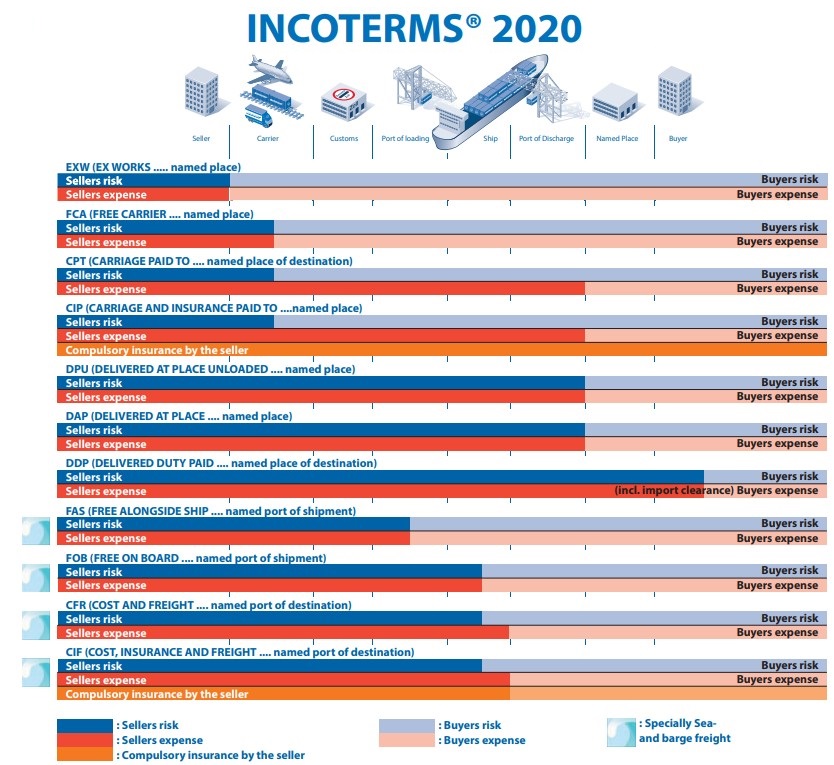
Teil – 5
Importvorgang
Steps
- 1). Making an order or quote request
Importer shall make a quote from suppliers for the goods they want to buy.
- 2). Issuing a Proforma Invoice
Upon receipt of the order, the exporter will issue an estimate proforma invoice stating that it may be subject to change later if required.
- 3). Agree to Incoterm
Both the importer and the exporter must agree to a specific Incoterm method for shipping.
- 4). Making a letter of Credit
The importer should apply for a letter of credit through his bank following the proforma invoice. His bank then issues a letter of credit to the exporter's bank promising to pay for the products.At our site, in most cases, you can use online payment such as Paypal instead of a letter of credit. It will keep your money safe until the goods arrive at your door or place. The advantage here is that you can reduce bank fees and delays and make the payment process faster and make it from home.
- 5). Issuance of Commercial Invoice
Following the letter of credit, the supplier will issue a commercial invoice to the importer confirming the order. This invoice is the main document required for clearance of goods, describing the price and quantity of the goods sold and the incoterm.
- 6). Contacting freight forwarders
The seller or importer will set this up on their incoterm. The freight forwarder contacts the relevant supplier and exports the buyer's goods. Freight forwarders provide International freight forwarding and preparation of key documents used in the process.
- 7). Customs clearance
The goods are subject to import clearance upon arrival at the buyer's destination. Imported goods may be subject to certain taxes, duties, and/or fees in each country.
Import Permission / Permission:Importers may need to obtain an import license depending on the type of goods they are importing into a country. This is not mandatory for all goods, but if a supplier or buyer imports or exports prohibited goods, they may need a special license depending on which goods they decide to import or export. On the other hand, if you have an import license, you can get customs or tax benefits.
- 8). Delivery of goods to the buyer
Goods will be delivered to the importer or delivered to the relevant point of delivery if clearance is done properly through customs, According to the incoterm that takes place during shipping will determine who sets this up.
If the goods are damaged, the importer must notify to supplier or shipper within 03 days. If you have obtained cargo insurance, this will be done according to your goods insurance policy, otherwise, you will have to bear the cost of damages.
All of the above steps can be handled by an importer or exporter's licensed customs broker and freight forwarder. They will bring the goods to your doorstep or place for you named. All you need is to find the right product from the right exporter.
Teil – 6
Sonstiges
Import & Export
- Export Guidelines
- Individual countries will have specific requirements in terms of the types of documentation needed for products being imported. The requirements will differ depending on the country and the specific type of product.
- Within the European Union (EU) there is free movement of goods. Free movement is where goods, including food products, can freely move within the EU without customs checks, although there may be national controls where there are risks to public health.
- Local Authorities have the authority to sign export certificates to companies who wish to export certain food products to other countries. So please get those certificates before you export and send us copies to register you as a food exporter.
- Useful Websites
- Sri Lanka
- European Union
https://ec.europa.eu/food/horizontal-topics/international-affairs/import-conditions_en
- Gulf Foods Export & Import
- Import foods to Australia & New Zealand
https://www.agriculture.gov.au/import/goods/food
- United Kingdom
- USA
https://www.fda.gov/food/guidance-regulation-food-and-dietary-supplements/food-imports-exports
- China
- CE Mark
Manufacturers play a crucial role in ensuring that products placed on the extended single market of the European Economic Area (EEA) are safe. They are responsible for checking that their products meet EU safety, health, and environmental protection requirements. It is the manufacturer’s responsibility to carry out the conformity assessment, set up the technical file, issue the EU declaration of conformity, and affix the CE marking to a product. Only then can this product be traded on the EEA market.
If you are a manufacturer, you have to follow these 6 steps to affix a CE marking to your product:
- Identify the applicable directive(s) and harmonised standardsSearch for available translations of the preceding linkEN•••
- Verify product specific requirements
- Identify whether an independent conformity assessmentSearch for available translations of the preceding linkEN••• (by a notified body) is necessary
- Test the product and check its conformity
- Draw up and keep available the required technical documentation
- Affix the CE markingSearch for available translations of the preceding linkEN••• and draw up the EU Declaration of Conformity (27 KB).
These 6 steps may differ by product as the conformity assessment procedure varies. Manufacturers must not affix CE marking to products that don’t fall under the scope of one of the directives providing for its affixing.
For products that present higher safety risks, safety cannot be checked by the manufacturer alone. In these cases, an independent organisation, specifically a notified body appointed by national authorities, has to perform the safety check.
The manufacturer may affix the CE marking to the product only once this has been done.


